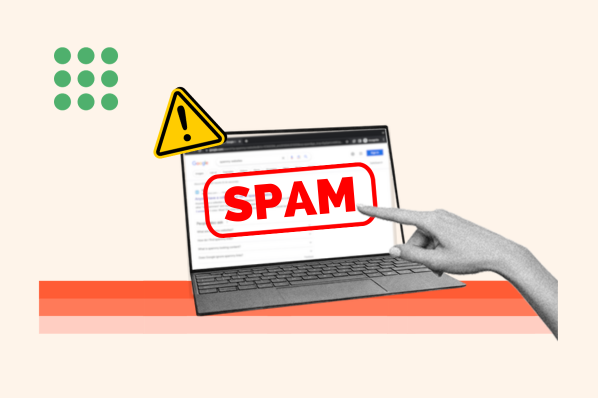In this post, we’ll cover:
- 8 Qualities of a Search Engine Web Spammer
- Spam Website Example
- What then, Does Google Care About?
- How do you track all this?
- Let’s say you did get penalized. How would you know?
8 Qualities of a Search Engine Web Spammer
Google’s overall goal is to help people find helpful content without any roadblocks, and its strict content and spam policies support that goal.
It’s entirely possible that something you do accidentally, with no malicious intent, flags Google to investigate your site as spam. Because of this, it’s worth familiarizing yourself with what is considered spam to prevent any action by Google that could place your site lower in search results or stop it from showing up at all.
Here are some examples of what Google considers spam:
1. They Rarely Use Social
Spammers simply don’t dedicate the time to build relationships with people and, thus, are rarely found in social networks. Help to distinguish your website and marketing from web spam by building relationships online in social media with prospects and customers.
2. They Over-Optimize
The repetitive use of keywords in content, where they unnaturally appear word after word ... after word (you know what I'm talking about) — that’s referred to as keyword stuffing or, more innocently, over-optimization.
Call it what you will; it’s not a good practice either way. Most frequently, you’ll see repetitive keywords in the following areas: page titles, on-page copy, and in domain names/URLs. To prevent keyword stuffing, follow best practices for optimizing your content, and aim to write as naturally as you would speak.
3. They Don’t Focus on Content
Spammers don't care about creating quality content — or content that is unique in any way, for that matter. In fact, spammy sites will often consist of stolen content, content repeated again and again, or content pulled in via RSS feeds from other websites. Avoid this type of spammy behavior by ensuring all the content you publish is unique and compelling.
4. They Stuff Their Sites With Ads
Spammers create the type of websites where more than 50% of the content on any given page is advertisements. Remember, the spammer’s goal is to make a lot of money, and running a ton of ads will help get them to that goal. Don't risk looking like a spammy site. Make sure to dedicate the top half of your web pages to content and calls to action. Don’t waste valuable website real estate with third-party advertisements that add no value to your business or its users. Google is not a fan of excessive ads on websites, and they'll ding you for it.
5. Their Sites Have Lots of Dead Ends, Pages Not Found, and Broken Links
For a spammer, maintaining a legitimate website requires too much upkeep that they just let pages expire and neglect to make necessary updates and changes. As a marketer, commit to keeping your website fresh and up to date. It pays to do some housekeeping, so don’t let the cobwebs build up.
6. They Attract Lots of Low-Quality Inbound Links
Unfortunately, there is such a thing as bad, low-quality inbound links because, after all, who links to spam except for spam?
A great source of quality inbound links is high-quality content you create that naturally entices other websites to link back to it.
Another great way to attract high-quality inbound links is through guest blogging, so leverage your networks to help build a stronger reputation and more powerful influence online. And if you have attracted some subpar inbound links in the past, consider using Google's disavow tool to help clean up your online reputation.
7. They Own Lots of Domains or Microsites
Spammers are notorious for not only purchasing lots of domains, but also setting up site after site that consist of just one page each and never gets updated. Of course, there are some exceptions to this, but as a best practice, try to keep all your content on one primary, authoritative domain/website.
8. They Employ Other Traditionally Black-Hat Tactics
These tactics include things like doorway pages, text that matches the page's background color (so the human eye can't catch it, but search engines can index it), and the use of misspelled content and keywords intentionally used wrong just to rank.
Some examples of black-hat tactics are:
- Cloaking - Presenting different content to viewers and search engines to purposely manipulate rankings.
- Hacked content - Any content placed within a compromised website or site pages by hackers, like malware.
- Malware and malicious behaviors - Google checks to see if there is content within sites that will cause a negative user experience, like malware that installs harmful software without user consent.
- Scraped content - Any content taken directly from a site and put on another without explicit permission or transfer of rights.
- Sneaky redirects - Bringing users to a different URL than what they originally clicked on.
- Spammy automatically-generated content - Auto-generated created for the sole purpose of manipulating search rankings because it doesn’t add any original insight or value to a user.
Spam Website Example
Below, we’ll review a few examples of website spam to give you an idea of what it can look like.
1. Blue Nile
Google says keyword stuffing is filling a page with keywords to manipulate search rankings, and the keywords often appear unnaturally. Blue Nile is a diamond jeweler selling rings for multiple occasions. Its blog post, Top 20 Engagement Rings, is an example of a practice that could be considered spammy.
What went wrong: Keyword stuffing
Repeated use of “engagement ring,” “top engagement ring,” and “ring” keywords and related keywords could be seen as keyword stuffing. While this brief section is not full of keywords, the words are used in close succession in one paragraph, and it sounds unnatural when reading the paragraph aloud.

2. Petminderpro
Scraped content on a website is copied and republished from another site without adding new content. Petmindperpro’s entire website is an excellent example of spammy website practices.
What went wrong: Scraped content
Petminderpro’s entire website is content scraped from the HubSpot Blog. It doesn’t provide any added unique content or insight to add to the taken content, so it has essentially republished an entire website’s content.

3. MyArea Network
Google defines doorway pages as intermediary pages a searcher lands on that aren’t as useful as the final destination page, like a site having multiple pages targeted at specific regions or cities and pages that funnel visitors into the actual usable portion of their site. MyArea Network is a great example of this.
What went wrong: Doorway page
MyArea Network’s website is a doorway page because it features city or regional pages for 100+ cities in the United States. To find a city, a user lands on the initial intermediary doorway page with no helpful content.

Yes, it is possible to innocently fall into the trap of some of Google’s spam triggers because you’re unfamiliar with SEO or haven’t monitored your website’s SEO activities. And while it sounds enticing to be on page one of the search results and generate a lot of traffic, you need to ask yourself: At what cost?
One of the best ways to ensure your site never receives a manual action because of spam is to optimize for what Google cares the most about.
What, Then, Does Google Care About?
Google wants you to create the best possible user experience for your site visitors by optimizing for on-page SEO (keywords) or off-page SEO (attracting inbound links).
The websites that succeed at doing this are the ones that get rewarded with good rankings, traffic, and, ultimately, conversions. Those who fail or practice any of the spammy behaviors above either end up not appearing in search results (at best) or getting penalized by Google (at worst).
What Marketers Should Focus On
Focus your efforts on what’s best for the visitors of your website. They’re the main consumers of your content and use search engines to find your work. Rather than focusing on specific tweaks (AKA "gaming the system") to gain rankings, focus on putting your site’s best foot forward and aim to please your ultimate consumers: your users, customers, and prospects…not search engines.
The most important thing is aiming for consistent quality content that delivers clear value and shows attention to detail. Create content (with “content” being more than just text— think images, video, rich text, reviews, comments, etc.) that is innovative, unique, and inspiring — in other words, compelling.
To deliver the right results to searchers Google focuses on five main factors: meaning, relevance, quality, usability, and context.
- The meaning behind a searcher's query (the most likely reason they’re searching).
- The relevance between the search query and the content on a website or site page.
- The quality of the content on a page and whether it adheres to the E-E-A-T model (we’ll outline this below).
- The usability of a site, which considers technical aspects like page speed and mobile friendliness.
- The context of the search, like someone's past search behavior or unique settings like location or language.
You can use these factors as a guiding principle when optimizing your site. For example, when it comes to usability, focusing on the technical aspects of your site will help you meet that standard.
When it comes to the content you house on your site, the E-E-A-T standard is the best model to follow. Here’s what it stands for:
- Expertise: You’re a subject matter expert in the content of your website. With spammy sites, a website that features many unrelated topics could be seen as spammy because the likelihood of expertise in so many topics is low.
- Experience: You have personal experience with the content you write about. You could be seen as spammy if there is no evidence of your expertise in the topics you write about.
- Authoritativeness: You have backlinks from credible sites. You could be marked as spammy if you have backlinks from sites that Google has already deemed spammy.
- Trustworthiness: Your website and its content are credible and current. Incorrect content and spammy practices (like the ones mentioned above) can strike against you.
Designing your site around your visitors’ needs while ensuring it's also easily accessible to search engines usually produces positive results. It helps users find the content they want faster and ultimately convert. It’s a win-win situation.
If you want to check how your website currently measures up to optimization best practices, consider running an SEO audit. It’ll help you determine whether your site will help you achieve your goals or if you might risk being deemed spammy by Google. HubSpot’s free SEO Audit Kit includes 60+ tips for running an SEO audit and a step-by-step guide you can follow to run one for your site.
Download HubSpot’s Free SEO Audit Kit
How Do You Track All This?
You'll need to keep track of key metrics to determine whether your SEO efforts are paying off and whether your content aligns with your users and creates that desired user experience. Evaluate how users are consuming your content. Sure, you'll want to look at pages visited, but think a little bit outside the box.
- Time on Site: Keeping track of time on site using a web analytics tool like Google Analytics is a good way to get insight about whether people like consuming your content. Now, depending on your type of content, users may not be spending that much time per page. Depending on the nature of your site, your target duration for a visit will vary.
- Bounce Rates: Google has publicly stated that bounce rate does not factor in as part of its ranking calculation; however, bounce rate (which a web analytics tool like Google Analytics can also report on) can give you some information about user experience. The average bounce rate for web analysts responding to our Web Traffic & Analytics Report is 37%. A healthy bounce rate for a site that produces a large volume of content is 70% or less. There are a few things to remember when looking at this metric. Look at it on a page-by-page basis, and consider that each page will have its own unique bounce rate. Some pages will naturally have higher rates than others, and that’s okay. You would expect that especially from something like your 'Contact Us' page, for example. There are additional ways to measure bounce rate, as discussed by Avinash Kaushik here.
- Clickthrough Rates (CTR): There are several different types of clickthrough rates you can look at, but I would recommend two types in particular. First, track the clickthrough rates of your search listings, which Google Analytics will provide to you if you have Webmaster Tools set up for your website. Generally speaking, you will have lower CTRs where you do a poor job of communicating what your site is about — meaning your Page Title, URL and description don’t align, or you have a poor site structure. Second, track the CTRs for your various calls-to-action (CTAs) on your web pages. Remember, one of the main goals for getting your web pages to rank well in search is to get people to click through to an offer. Therefore, your CTA clickthrough rates on those pages will tell you how effectively your traffic is getting routed to the landing pages for your offers.
- Conversion Rates: Once you get people from search engines to your landing pages, they still need to fill out the form and convert! Conversion rates should be tied directly to your business goals. A conversion might be completing a purchase, signing up for a mailing list, or downloading a whitepaper.
- Social Signals: Social media is about relationships, and your social signals are the metrics that help you determine whether your content is being shared on social media — and the impact it's having. Beyond tracking the number of Likes and shares for your content, also consider the following (which you can track using a closed-loop marketing analytics tool like HubSpot): traffic from social media (and individual social networks), overall social media reach, and how many leads and customers you can attribute to your social media presence. Remember — social media influences SEO, so it's important not to ignore that fact.
We have entire blog posts and ebooks dedicated to explaining and exploring SEO and marketing analytics, so you’ll excuse me if my explanations just scrape the surface. One way to improve your site is to look at it from the perspective of your users. What shows up in search results: is it enticing? Does it accurately represent the content of my website? Am I giving searchers a reason to click on my listings? And the same applies to content within your site, too. Give users the information they seek.
Let’s Say You Did Get Penalized. How Would You Know?
If you suspect you have been penalized in search engines for spammy behavior, there are a few things you can check. Start with the following:
- Do you show up in the search results? You can start by simply doing a search for your site. Searching for your site with the following command (search:domain.com) will give you a sense of what’s indexed.
- Check your traffic metrics — volume and sources. Has your traffic remained the same or at least steadily increased? If so, that’s good. If, however, your traffic shows any sudden drop-offs without a rebound, it's an indication you may have been dinged.
- What types of links come in to your website? Take a look at the type of inbound links you've attracted for your site. Do any of them look suspicious?
- Are you still generating leads? Traffic alone isn't the only factor to consider. If you've stopped getting conversions and leads without changing much or without reducing the volume of content and offers you produce, I would encourage you to look into it further.
While there are certain steps to take (like this one) if you feel you've been penalized by Google unecessarily, the best way to start reparing your search engine rankings is to clean up your black-hat SEO practices and move forward with a more white-hat approach.
Focusing on your users is the best protection against spam.
In the end, you want to ask yourself, "What do my users care about?" If you can focus on creating content while keeping your users in mind, all of the above will be super simple.
Do what’s in your audience’s best interest and write as though you're having a conversation with that person. Use your website as a tool to communicate, engage, and build trust and authority. That’s all that Google expects of you. Web spammers, on the other hand, manipulate users and search engines, ultimately creating a less than optimal experience for them as a result. Don’t be that guy.
Are you optimizing your website and content with the user in mind?
Technical SEO




![The top search engines other than Google [+ some you might not expect]](https://53.fs1.hubspotusercontent-na1.net/hubfs/53/other%20search%20engines%20header%20image%20.jpg)







